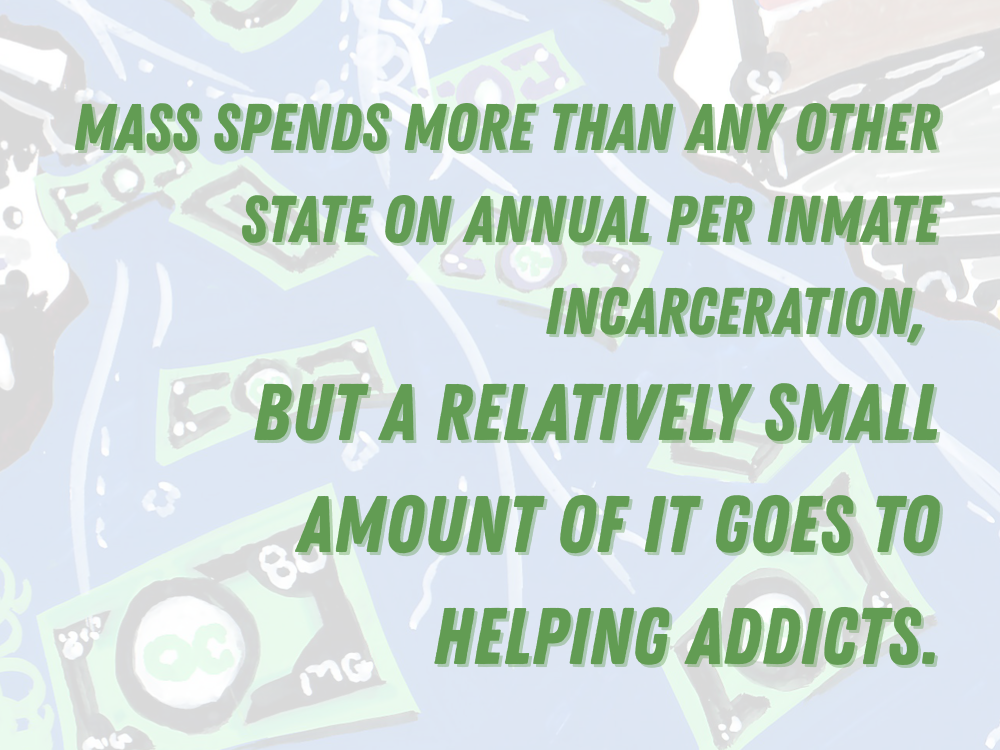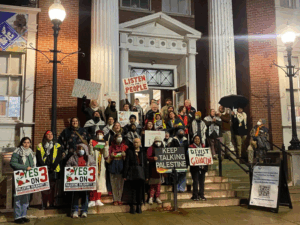The commonwealth will receive more than a billion dollars for opioid remediation—none of it is for the state’s most vulnerable drug-dependent population
There are countless shocking data points which highlight the torrential impact of opioids on Massachusetts. Decades into the storm, many people are familiar with some of the troubling statistics, even if they have become desensitized to the enduring horror.
In one revealing longer-term analysis, research by the Department of Public Health’s (DPH) Substance Abuse Services office showed that while “in 2000, about one third of admissions to substance abuse treatment centers and programs were opioid-related,” “by 2015, that figure had increased to more than half, overtaking alcohol as the most prevalent substance recorded at treatment intake.”
Ten years later, the nightmare continues, now fueled by increasingly deadly narcotics, from unstable fentanyl analogs to newfangled nitazenes. Mass has recently seen year-over-year decreases in opioid-related overdose deaths, but that is in the wake of hundreds of millions of dollars spent to save lives, and more than two-thousand people are still dying annually. The epidemic also tests the resources of courts and prosecutors, and plays a bleak central role in the culture of local jails and state prisons.
If there’s any hope among recovery crusaders, first responders, and exhausted health care workers who have wrestled this quagmire for ages, it is that funding is finally flowing through Mass, as well as other states, to mitigate the scourge. In short, nearly 20 companies responsible for pushing so much poison—including the notorious OxyContin makers Purdue Pharma—will pay more than $50 billion to state governments over the next two decades to settle multiple class action lawsuits.
As the Boston Institute for Nonprofit Journalism (BINJ) previously reported, money from these settlements began coming into the Bay State about four years ago. An early contribution came in 2021 when consulting giant McKinsey & Company agreed to pay $573 million nationally (including $13 million to Massachusetts) to settle claims regarding its advice to pharmaceutical companies on maximizing opioid sales. The commonwealth anticipates receiving more than $1 billion by 2038 for opioid abatement efforts, with more than $300 million already disbursed.
The state has gone to great lengths to equitably parse the largesse, but there is a particular group, one of the most devastated demographics of all, that the grantors apparently overlooked.
Substance abuse in Massachusetts correctional facilities
National studies show that more than half of incarcerated people meet the criteria for having a Substance Use Disorder (SUD). Complicating matters is the intersecting impact between drugs, the war on them, and American prisons; research by the Northampton, Mass-based Prison Policy Initiative shows that nationally, one in five incarcerations is for a drug offense.

In Mass, many people caught in the synthetic storm come under the care of the Department of Correction (DOC). One DPH study showed that the opioid overdose death rate was “120 times higher for those recently released from incarceration compared to the rest of the adult population.” Anecdotally, sources who spoke about getting high inside of the state’s institutions said the mess is manifold, featuring the aforementioned substances as well as newer burdens like the dangerous lab-concocted cannabinoid K2.
According to the state’s own research, the risk of opioid-related overdose is especially high “in the immediate post-release period.” All damage considered, one might think the commonwealth would dedicate a portion of its drug abatement funding to the DOC. The department oversees more than 6,000 people in 14 facilities, all at the crossroads of every pill, sublingual film, and powder trend, including abuse of the commonly prescribed medication-assisted treatment (MAT) agonist buprenorphine that’s found in Suboxone.
But while there is language in state guidelines which suggests remediation dollars could go directly to state prison programs, no such help is on the way. According to a department spokesperson, the “DOC has not received funds through this settlement.”
That seemed remarkable enough that we also asked the DPH if state prisons had already or will in the future receive any of the billion dollars dedicated to this cause. Those media relations people directed us to the Executive Office of Health and Human Services (EOHHS), which oversees the health department. They didn’t respond to our questions either.
Were prisons intentionally left out?
Settlement funds are divided between local governments and the commonwealth per the State-Subdivision Agreement for Statewide Opioid Settlements. Under this agreement, 60% of the money from agreements with Big Pharma go to an Opioid Remediation and Recovery Fund, controlled by the EOHHS, while cities and towns receive the remaining 40%, which is supposed to be allocated toward recovery efforts.
Our prior reporting showed that more than 90% of those municipal dollars went unspent in the first two years. Of the funds that were expended, a significant amount was directed toward administrative costs, while in some places, money meant to address opioid fallout has gone to law enforcement. (Updated data from FY25 is not yet available, but is expected to be published soon).
On the EOHHS side, Mass is spending millions of abatement dollars annually on priorities including “equity,” like “Black and Latino Men’s Re-Entry program sites,” as well as on “expanded access to medications for opioid use disorder (MOUD),” and “low-barrier recovery housing options and other basic needs support.” But while the state’s “commitment to abatement,” signed by then-Attorney General Maura Healey in 2022, notes an intent to address “the needs of criminal-justice-involved persons,” including by supporting “diversion and deflection programs and strategies for criminal-justice-involved persons with OUD,” there’s no specific mention in the guidance document of the DOC or incarcerated people. Rather, the focus is loosely put on “Programs, that connect individuals involved in the criminal justice system and upon release from jail or prison to [Opioid Use Disorder] harm reduction services, treatment, recovery support, primary healthcare, prevention, legal support, or other supports, or that provide these services.”

One section, on “harm reduction,” seems to deliberately exclude those who are currently imprisoned, noting that some opioid remediation funding should go to supporting “persons being released [emphasis added] from jail or prison,” among other impacted parties like schools and community-based organizations.
Additional correlative priorities apply more to law enforcement officers and other professionals who work with the “criminal-justice-involved” population, as opposed to that actual population. They include: “Support … Co-responder and/or alternative responder models … [and] Public safety-led diversion strategies,” and, bluntly, “Participate in membership organizations such as the Police Assisted Addiction Recovery Initiative.”
Prior BINJ reporting examined how money meant to defray the impact of opioids and prevent further tragedy has been allocated across Massachusetts. Our team found that while the DPH advises municipalities against “funding law enforcement and/or first responders to engage people who use drugs (PWUD) through post-overdose outreach and/or other engagement efforts,” some cities and towns have ignored this guidance.
In response to questions about the expenditures, an official in Mansfield in Bristol County told BINJ the local government there is “facing difficult budget decisions and the opioid funding ensures we are able to keep our [Problem Oriented Policing] Team fully funded and active in the community.”
As for the people they arrest, whether they receive the support they need if they’re convicted and sentenced depends on where they get locked up.
A problem bigger than the DOC
According to the Prison Policy Initiative, there are about 16,000 people from Massachusetts behind bars. As a result, the Bay State “has an incarceration rate of 241 per 100,000 people … meaning that it locks up a higher percentage of its people than almost any democratic country on earth.”
That 16,000 figure includes the approximately 6,300 DOC prisoners, as well as some 1,300 known federal prisoners and about 8,300 in county jails and houses of correction (HOC). People with OUD in those settings must be offered FDA-approved medications (buprenorphine, methadone, or naltrexone). In a slightly different protocol from how addicts are managed in the DOC, since 2018, Mass law also stipulates that “HOCs must offer to continue MOUD for individuals receiving it prior to detention, initiate MOUD prior to release among sentenced individuals where appropriate, and facilitate continuation of MOUD in the community upon release from incarceration.”

There’s not nearly enough money in the system to support these mandates though. According to a study funded by the National Institute on Drug Abuse that was published earlier this year, “Given the budget constraints faced by jails, the investment required to implement/sustain an MOUD program will likely result in the need to obtain additional funding or reallocate existing resources away from other initiatives.”
Due to the close relationship between many sheriffs’ departments and the municipalities in their jurisdictions, it is inevitable that cities and towns, which receive annual payouts from the Opioid Remediation and Recovery Fund, will assist with an increasing amount of that required post-release care. Our interviews with stakeholders across the state suggest a willingness in that direction. But HOC-town hall collaboration will have to happen organically; while there is a lot of focus in official documents regarding equity and directing abatement money to the most vulnerable communities, there is no mention of the state’s 14 HOCs.
As for the DOC, the agency is on its own in managing the epidemic, left to fight the battle using state tax dollars along with unreliable federal grants. It’s a seemingly large amount; according to one recent legal analysis that accounts for more than just the DOC budget (which on its own averages just over $200,000 per inmate per year), Mass spends more than any other state on annual per inmate incarceration, about $307,000—but a relatively small amount of it goes to helping addicts. And the expenditures are like Russian nesting dolls, making it hard to ascertain exactly what is used for who and where beyond the line items.
In 2024, Mass spent $22.8 million on the DOC’s Massachusetts Alcohol and Substance Abuse Center (MASAC) in Plymouth, “a unique facility that houses civilly committed male patients participating in an up to 90-day detoxification program,” plus just short of $5 million for all behavioral health and residential treatment programs across the system. That’s up from the $13.7 million spent on MASAC in 2020, but still less than 4% of the department’s $800 million-plus yearly budget. It costs more than $500,000 a year to treat one person at MASAC.
There is also a “Medication Assisted Treatment Re-Entry Initiative (MATRI) … to provide pre-release treatment and post-release referral for opioid-addicted and alcohol-addicted inmates at participating sites in the DOC.” But despite the state’s requirement to use remediation dollars to help “individuals involved in the criminal justice system and upon release from jail,” none of the settlements are going to reform or bolster MATRI or similar programs.
How opioid settlement funds could be used in Mass prisons
We asked some prison watchdogs and attorneys how millions of dollars in opioid remediation funds coming to Mass could help mitigate the current drug problem behind the wall. A few of them had interesting ideas, but mostly insisted that at the very least, more money should be funneled toward demonstrably effective prevention and treatments. They also said that nobody can answer these questions better than those who are incarcerated.

William “Billy” Duclos has been working to expose problems including those around overdoses at MCI-Norfolk for years. Along with others on the Norfolk Inmate Council, he has made several suggestions for changes that he says could save lives, but none have been implemented. In a September 2024 report, the NIC wrote: “Many of these suffering from [Substance Use Disorders] also suffer from other mental health disorders and the consistent DOC policy of punishment over treatment or security first has only sent them into a downward spiral.”
The report continued: “The lack of [mental health] care has fueled many to self medicate with illicit substances in the yard. Prisoners have indicated that the constant change in [mental health] providers and a lack of racially diverse [mental health] providers have created barriers in trust and treatment. Prisoners seeking treatment to address the factors of their crimes are not provided a treatment plan.”
Matteo Filippi is the board chair for Boston Project Rebound Reentry Services, an organization that helps recently incarcerated individuals reintegrate. “The system pushes pharmaceutical treatment before other treatments because money is easy to find and less time intensive,” he wrote in an email comment for this story.
Filippi added that [recovery drugs like methadone] “keep inmates ‘controlled’ and show that [the DOC is] trying to take care of [prisoners’] health.” Meanwhile, “many guys go from one addiction (street) to another (legal pharmaceuticals),” and “little is done to address talk therapy and spiritual components of their lives.”








